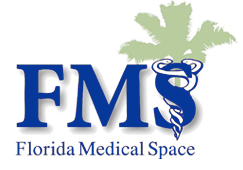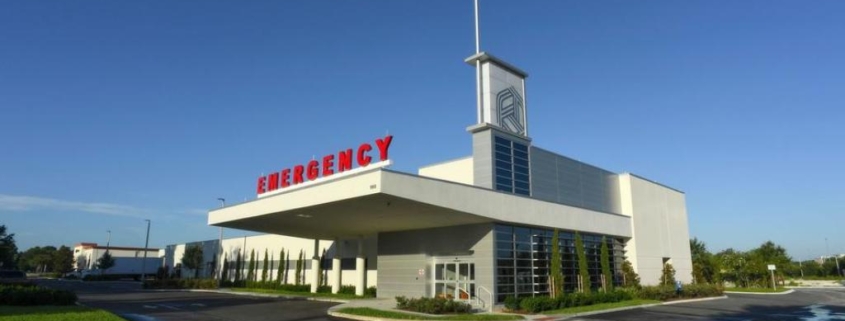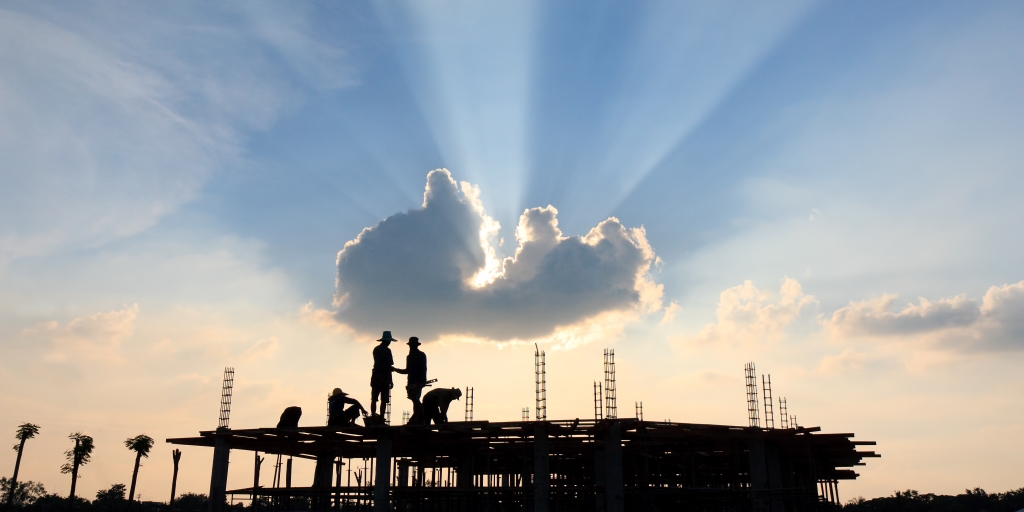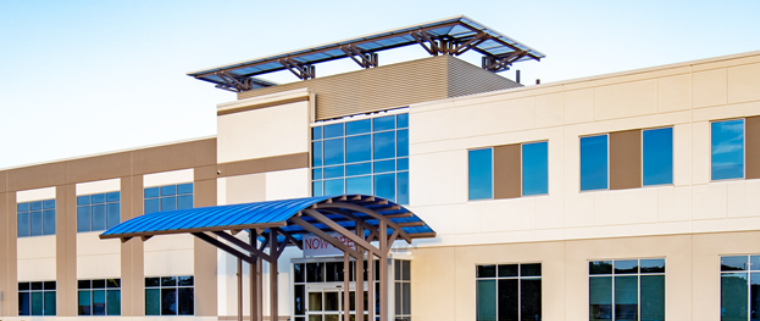Limiting entries, enhancing HVAC systems, compartmentalizing spaces, and creating hot zones are some of the recommendations made by local architecture firm HKS to prepare healthcare facilities for current and future pandemics. HKS released a report with details for short and long-term strategies that will help healthcare systems prepare for a potential second wave of COVID-19.
The company organized an ER COVID-19 Design Task Force made up of design, clinical, and engineering experts to compile and review effective strategies. The Task Force analyzed news stories, successful and unsuccessful facility responses, and previous publications to list eight possible concepts to help healthcare systems combat a second wave of COVID other infectious diseases.
Enhance Entry Functions
As COVID numbers began to rise, medical facilities started limiting the number of entries. Many even implemented a single-entry control point. Besides controlling entry levels, entry portals can also be used for many screening and safety functions such as providing protective personal equipment, collecting patient information, and identifying highly infectious patients.
Some short-term considerations for enhancing entry functions include providing PPE to wear when entering the facility, the use of various technologies such as rapid testing and temperature screening, and the installation of temporary materials like dry wall, plastic, or plexiglass.
Long-term considerations include providing storage for supplies like PPE and wheelchairs, inserting hand-washing stations near the entry, creating negative pressure capabilities, and providing space for new technologies that could strengthen diagnostic and security can help facilities manage future pandemics.
Support and Reinforce Personal Protective Equipment Management
PPE is an effective way to protect not only patients but health care workers. Different circumstances require different levels of PPE and how often it needs to be changed. Some hospitals have even created policies for reusing PPE in order to conserve it.
“PPE for decades has really been an afterthought design, which puts nurses in the position of using mobile or makeshift solutions for storage,” Sarah Holton, Vice President at HKS, said during an online seminar about the report. “Our opportunity as a design leader is to really advance the strategic placement of PPE in the design process. By carefully integrating PPE in the design dialogue, we more effectively support the principles of infection, prevention, and its use.”
Potential strategies to be implemented now include placing PPE at key entries, creating areas for donning and doffing the equipment, designating space for cleaning reusable PPE, and installing foot-operated door pulls. Looking ahead, the Task Force suggests separating donning and doffing PPE areas away from patient care areas, installing a sink at doffing areas, creating disposal stations into rooms near exits.
Bolster Resistance to Pathogens
Implementing effective policies can help strengthen resistance to pathogen threats and reduce the risk of infecting patients and staff. The concept of bolstering resistance to pathogens strategies considers water integrity, all surfaces, and air purity. Another thing to take into account when developing resistance to pathogens is the ability to remove all items from a room. One short-term modification is to use carts.
“We consider the use of carts rather than permanent cabinetry that can be removed so the room can be fully clean. Carts could be removed if unnecessary during the particular patient course of treatment.” Holton said. “Placing equipment outside of the room when possible to limit the need to go in and out of the room is very helpful.”
Other immediate modifications include implementing temporary negative pressure with exhaust to enhance isolation areas, placing select equipment outside of the patient’s room, covering high-risk surfaces with adhesive films that can be easily cleaned, labeling high-touch surfaces with specific signals that indicate to housekeeping staff that frequent cleaning is required, and using hydrogen peroxide misting or UV light disinfection.
Health care facilities can implement strategies such as using cleanable surfaces, using high touch strip concepts to enhance cleaning, providing access to equipment from outside of the room, creating a unidirectional flow suite that separates doffing and donning areas to help reduce contamination.
Enhance Heating, Ventilation, and Air Conditioning Systems
HVAC systems in medical facilities play an important role in stopping and destroying a virus from spreading throughout the hospital. Because many diseases can spread through the air, enhancing HVAC systems is an important step in limiting the transmission of diseases to patients and medical staff.
“Being a global company, we had the ability to start getting an understanding of what other regions were doing in Asia and in Europe,” Nolan Rome, Senior Vice President at engineering firm WSP, said. “It really came down to the basic premise of all healthcare, which is that directional airflow of clean to less clean and to pull that air using negative pressure and the contaminator away from the caregiver, as they provide care to the patient.”
Potential near-term policies that could help enhance HVAC systems include upgrading filters in air handling units to include High Efficiency Particulate Air final filters, operating the air handling units serving COVID-19 areas at 100 percent outside air with full exhaust, creating temporary negative pressure rooms with direct exhaust through HEPA filtration, and installing temporary ante-rooms for negative pressure isolation rooms with HEPA filtration.
Looking ahead, healthcare systems should consider pressure monitors for all areas that require pressure compartmentalization, designing air handling units for emergency department areas to handle 100 percent air for pandemic operation, implementing purge mode that will allow the entire ED to be exhausted, and validation of directional airflow patterns.
Strategize for Compartmentalization
The strategy of compartmentalizing a department into multiple zones can be effective in caring for different groups of patients. In order to successfully compartmentalize units, health care facilities must take into account access to critical resources, equipment, and supplies as well as accessibility, stairs and elevators, existing fire safety plans, and interstitial spaces.
“Looking at the long-term considerations and essentially something we do in our Asia practices regularly is to start to look at creating areas of compartmentalization,”Rome said. “We start to give ourselves a seasonal pandemic or a seasonal flu plan where we can isolate entire parts of the body and isolate entire patient wings, so we can give ourselves a parallel path to be able to treat our acute and relatively well patients in a way that allows for revenue stream that also allows us to process the pandemic patients at the same time.”
Changes in the near future for compartmentalization include using secured interlocking double doors, using tape, sealers, and caulk to limit air leaks, stock adequate supplies and equipment in each zone, and color-coding areas to visually represent the risk/precaution level and help establish safe behavior.
Long-range considerations include designing ventilation systems to isolate cohort compartments, using air pressure gradients that match the level of disease spread, and taking advantage of fire door requirements to create compartments.
Delineate Safe Zones and Hot Zones
During a pandemic, it may be difficult to establish a completely safe zone. Nevertheless it is important to create an area where healthcare workers are able to operate with less PPE and be safe from contamination. In order for the safe zone to be effective, medical staff need to easily understand the level of safety a zone needs and the delineation of the zone.
“This takes a look at how you would alter the corridor going into the room in a very simplistic way. Number one, outside of the room, you would have a great area which is for donning,”Jim Lennon, an ED Specialist said. ‘On the door and wall is a color-coded system representing various levels of infection. Similarly, you try to make your exit on the left side with hand sanitizer and some kind of PPE disposal.”
Other solutions to establish clean safe zones include using tape or stanchions in circulation areas to separate clean and potentially contaminated flows, creating color-coded floors, walls, or doors, making sure signs are simple to read across languages or creating universally recognizable icons, using portable screens to separate zones, and adding physical barriers where appropriate.
Color-coded doors, embedded LED lighting that change color to represent different conditions, the usage of different colors in flooring materials, and pass-throughs for equipment can help medical facilities establish effective safe zones in the future.
Expand and Facilitate Telemedicine Usage
During the pandemic, telemedicine became more widespread. Telemedicine prevents exposure and allows for the preservation of equipment.“We want to develop a security structure that utilizes all of these tools and establish a space that can support medical professionals providing telemedicine services and dedicated telemedicine rooms,” Holton said. “The idea is that [the telemedicine rooms] should ensure acoustic privacy, good speech clarity, adequate lighting, and clarity space expressions.”
Long-term strategies including considering a center where telemedicine can be coordinated, including a health system logo on the room or on the feed, considering on-site tele-triage, and establishing patient spaces for incoming telemedicine support.
Provide Surge Capacity
During the pandemic, ERs have been running at or beyond their capacity levels. In planning for the future waves, every space near the ER must be considered for re-purposing in order to handle the influx of patients.
Portable equipment to minimize the need for bedside electrical, rapid assembly of surge structures, using rigid structures, providing well stocked areas with high use clinical and cleaning supplies, zoning immediately adjacent surface parking areas for environmentally controlled deployable, and rapidly connecting to existing hospital sources of medical gases, water, electrical and data outlets.
When designing new facilities, features such as slightly over-sized ED treatment rooms, docking area for temporary structures, ED canopies that can be easily enclosed to become indoor spaces, pre-wire and pre-plumb common spaces with power increases a hospital’s ability to surge during a crisis.
Source: Healthcare DMagazine





